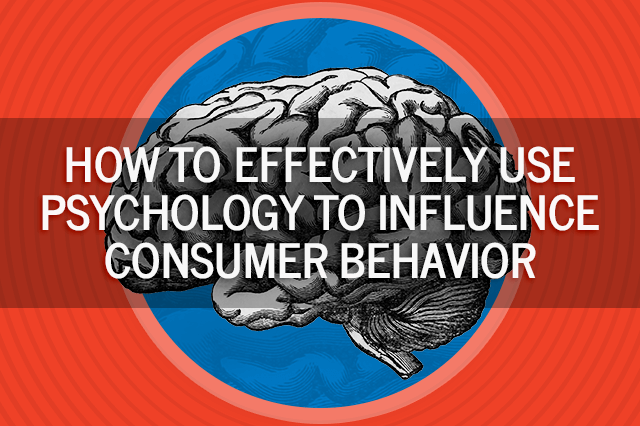How to Effectively Use Psychology to Influence Consumer Behavior
 June 11, 2018 | By Ilfusion Team
June 11, 2018 | By Ilfusion Team
A key aspect of a successful marketer is being able to understand the behavior of your consumers—why they act and think the way they do, and how internal and external factors affect their thoughts and decisions. This is why many businesses lean on psychology to bolster their marketing efforts: effective use of key principles in psychology can help attract the right audiences and demonstrate the very things that appeal to them.
Without a clear understanding of what influences the buying decision of consumers, your marketing efforts will not be as powerful. Here are ways to effectively use psychology in marketing to positively influence consumer behavior and ultimately compel them to buy:
1. Impact of colors
Color is more than just a design element; it’s also a subtle yet powerful marketing and branding tool to evoke certain feelings and to influence perceptions and behavior. Color plays a large role in conversion as well. Choosing a bright and vibrant color for your call-to-action (CTA) button, in contrast to the rest of your brand’s color palette, can effectively boost conversion rates.
Additionally, the way consumers perceive a brand can also affect their decision-making, and color plays a part on this as well. Certain colors such as red and orange generate a feeling of strength and warmth, while blue and green generate a feeling of calmness and trust. The more your target audience identifies with the emotion associated with your brand colors, the more this elicits a desired action. There are, of course, many factors at play here, not the least of which is differentiation in the competitive landscape. Color deserves thoughtful consideration.
2. Emotional vs. rational content
Studies show 31% of ads infused with emotional content performed better versus 16% of ads focused on rational content. By emotional content, this means demonstrating the product benefits instead of its features: What positive outcomes will consumers achieve when using your brand’s products/services?
While rational content—those that highlight the product features or explaining how they work—helps to educate consumers, these don’t typically elicit an emotional response, and thus is not effective enough to influence the buying decision of consumers.
3. Exclusivity and the human ego
People, in general, like to feel special and unique. Ego plays a large role into the buying decision of consumers, and most often, if people feel that they are treated specially, they are more than likely to be drawn to your brand.
Simply using the word “you” in your marketing copy helps build instant rapport and a feeling of exclusivity. The word shows that you’re invested in your target audience, that you care about them and personally identify with them. Offer discounts and promos to a selected few. Provide more in-depth blog content to consumers who sign up to your newsletter. The key thing here is to take an individualized and personalized approach to your customers.
4. Pricing psychology
For most practical and budget-conscious consumers, the price of a product is almost always the biggest deal breaker. However, there are certain pricing psychology strategies that can help you influence your audience’s purchasing decision to your favor. Anchoring is one important strategy that most marketers use, which postulates that people base their decisions on the first piece of information they receive. For example, when running a sale, marketers present the original price first, then display the discounted price next to it.
Moreover, it’s important to note that people are conditioned to think that prices ending in 9, 99, or 95 are associated with discounts and better deals—otherwise termed as charm prices. A study revealed that on average, using charm prices in business increased sales by 24% compared to rounded prices (e.g., $2.99 vs. $3.00).
5. Elicit strong emotions
FUD—fear, uncertainty, and doubt—are one of most utilized strategies in marketing. It emphasizes the consequences of not taking action; for example, if a user attempts to ignore a newsletter opt in, you can word your copy to something like, “No, I don’t want more sales.” Another tactic is to present scarcity with your offers, such as a limited time offer. Of course, playing into strong negative emotions too much can cause your marketing efforts to backfire.
It’s also equally important to elicit strong positive emotions. Humorous and tongue-in-cheek advertisements almost always draw people’s attention in, but inspirational and sappy ads can also work well. The essential strategy in eliciting strong emotions in advertising—whether negative or positive—is to know what appeals to your target audience better at a given time: What are their pain points? What makes them laugh? What do they empathize with?
Psychology is a versatile branch of knowledge that can be applied to virtually anything related to people. Its use in marketing is almost always undervalued but, when used properly and consistently, can help reap remarkable rewards, far more than being able to drive sales—it also helps connect with customers at a deeper level.
At Ilfusion, we prefer to use our powers for good; connecting people with the products and services that will improve their lives. With that said, it is valuable to know the psychological triggers to help make that happen.
If you want to know more about effective marketing strategies, or if you’re interested in working with Ilfusion for any of your marketing needs, give us a call at 888-420-5115, or send us an email to cr******@******on.com.
Filed in: Marketing

